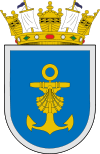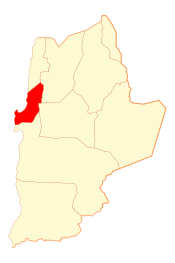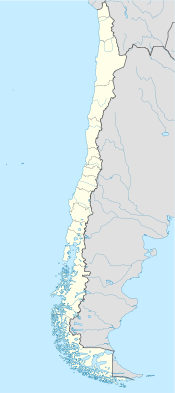- Mejillones
-
Mejillones — City and Commune — 
Flag
Coat of armsMap of Mejillones in Antofagasta Region Location in Chile Coordinates (city): 23°06′S 70°27′W / 23.1°S 70.45°WCoordinates: 23°06′S 70°27′W / 23.1°S 70.45°W Country Chile Region Antofagasta Province Antofagasta Founded 1842 Government - Type Municipality - Mayor Area[1] - Total 3,803.9 km2 (1,468.7 sq mi) Population (2002)[1] - Total 10,042 - Density 2.6/km2 (6.8/sq mi) - Urban 7,888 - Rural 530 Demonym Mejillonino Sex[1] - Men 4,654 - Women 3,764 Time zone CLT (UTC−4) - Summer (DST) CLST (UTC−3) Area code(s) 56 + 55 Website Municipality of Mejillones Mejillones is a Chilean port city and commune in Antofagasta Province, Antofagasta Region. Its name is the plural form of the Spanish mejillón meaning "mussel", referring to a particularly abundant species and preferred staple food of its indigenous inhabitants. It is situated in the northern side of the Mejillones Peninsula, 60 km north of the city of Antofagasta. To the west, in the northern part of peninsula, is Punta de Angamos, site of the naval combat of the same name, fought during the War of the Pacific.
Mejillones is surrounded by the waters of the Pacific Ocean to the west and by one of the most arid deserts in the world to the east, the Atacama. It also marks the country's widest point along a parallel (362 km).
Contents
History
The settlement of Mejillones dates back to the first communities of Chango people who inhabited the coastal area from 1825.
Between 1838 and 1839, French businessmen known as "Hermano Latrille" ("Brothers Latrille"), contracted mining services of the Copiapino Juan López (miner known as Chango Lopez, considered the founder of Antofagasta), to mine guano deposits located south of Mejillones. In this manner, Luan López began ming around the vicinity of San Luciano hill in 1841. The concession for the mining of this raw material was obtained by Domingo Latrille at the hands of the Bolivian government, which would last until 1842. Between 1841 and 1842, they made the largest shipments of this product to Europe.
In 1845, President of Bolivia Manuel Isidoro Belzu had a small fort built on the south side of Mejillones, to become a minor port of Bolivia. The Bolivian government proposed, through the development of a project, to establish a major port city in the enormous jurisdiction of Mejillones.
In 1866, Bolivia and Chile mutually agreed to finance the construction of the Oficinas de Administración y Resguardo de Aduanas ("Offices of Administration and Security of Customs") with officials of both countries as a way to protect the interests of Chilean workers and for the implementation of the Bolivian government of a tax rate on the export of minerals, primarily salt and guano. Subsequently, one of these buildings was transferred to the city of Antofagasta during the War of the Pacific. Currently, this building is still in force and designated as the Regional Museum in the city.
On October 8, 1879, the Battle of Angamos was fought here in front of the peninsula of Angamos between the Chilean and Peruvian navies, which ended in the Chilean capture of the monitor Huáscar. Afterward, the increasingly prosperous nitrate industry showed a boom going through the port at Mejillones, where the mineral boarded on the Antofagasta railroad left for foreign ports abroad. During this time, strong waves wreaked havoc on the shipping facilities, which required the reestablishment of Mejillones, this time reborn under the Chilean flag.
Also after the War of the Pacific, administrative organization began, which in the case of Mejillones wiould involve the preparation of urban planning in agreement with the existing type of port. This work was commissioned to naval engineer Emilio de Vitds. The plan, which was perhaps more realistic than those proposed before, was based on 63 city blocks and was completed with the Foundation Act (Acta de Fundación), signed by president Germán Riesco and dated February 7, 1906.
In 1970, a majority vote approved the bill presented by Mayor Araya Cuadra to build a theater located across the rear of the Plaza Almirante Latorre. The work was carried out with the grant of a loan by the Ministry of Housing and Urban Development in the amount of $500,000. Such funding would not satisfy the completion of the project, and work stopped in 1972 pending the granting of a loan extension that failed to materialize by the time of the coup of the Armed Forces of September 11th of 1973.
Demographics
According to data from the 2002 census by the National Institute of Statistics, the Mejillones commune has 10,042 inhabitants; of these, 7,888 (78.6%) live in urban areas and 530 (5.3%) in rural areas. At that time, there were 4,654 men and 3,764 women residing in the commune. In the ten years since the previous census of 1992 (pop. 6,315), the population grew 33.3% (2,103 persons).[1] It is expected to grow after the construction of Megapuerto de Mejillones, due to be Chile's biggest sea port, expected to be completed around 2030.[citation needed]
Administration
As a commune, Mejillones is a third-level administrative division of Chile administered by a municipal council, headed by an alcalde who is directly elected every four years.
Within the electoral divisions of Chile, Mejillones is represented in the Chamber of Deputies by Mr. Pedro Araya (PRI) and Mr. Manuel Rojas (UDI) as part of the 4th electoral district, (together with Antofagasta, Sierra Gorda and Taltal). The commune is represented in the Senate by Carlos Cantero Ojeda (Ind.) and José Antonio Gómez Urrutia (PRSD) as part of the 2nd senatorial constituency (Antofagasta Region).
References
- ^ a b c d (Spanish) Instituto Nacional de Estadísticas
External links
- (Spanish) Official website
< Communes and municipalities in Antofagasta Region > Antofagasta Province 
El Loa Province Tocopilla Province Categories:- Antofagasta Province
- Communes of Chile
- Port cities in Chile
- Populated places established in 1879
- Populated places in Antofagasta Province
Wikimedia Foundation. 2010.



